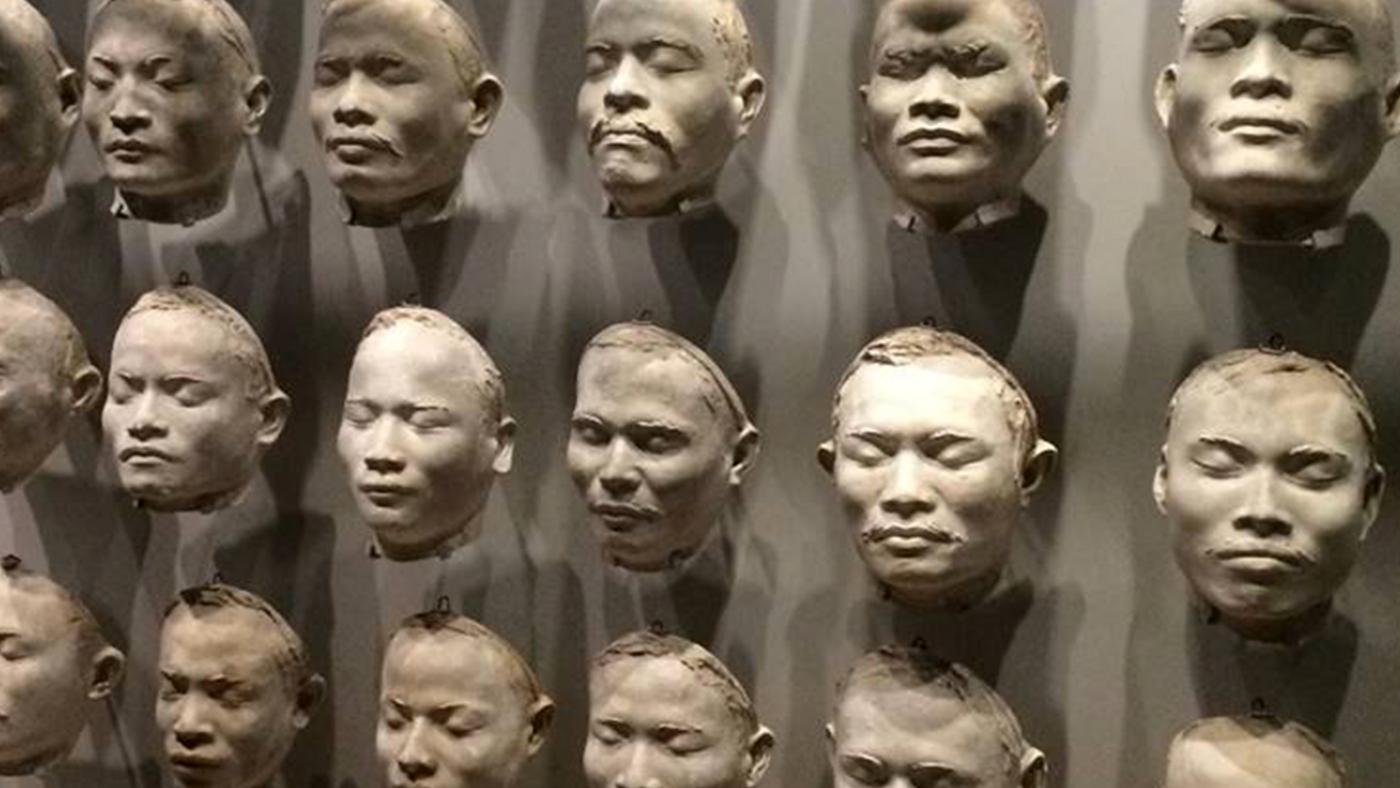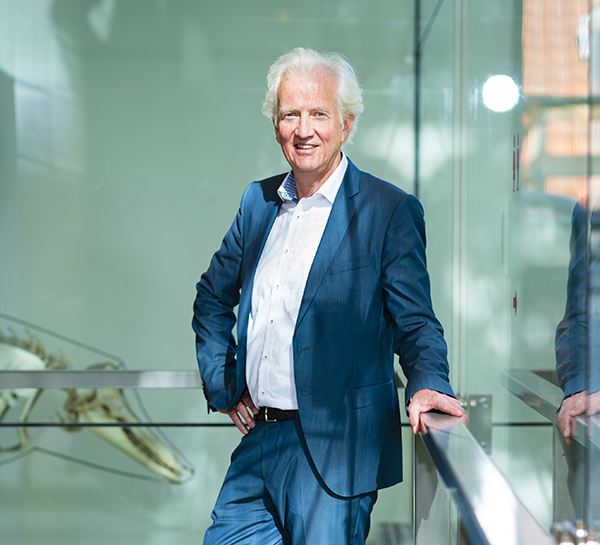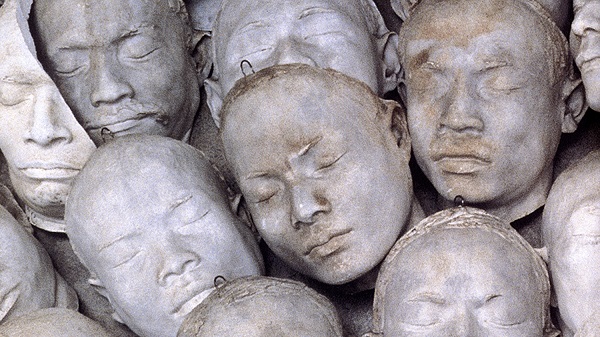Research hopes to shed more light on the story behind UMU’s Nias masks

Currently, because of the measures to contain the pandemic, it’s not possible to see the Nias masks in the basement of the Carolien Bleeker building, in the Utrecht Science Park. Thirty of them are kept in a large drawer in one of the University Museum’s storage rooms. On photos and video footage, the white faces with their eyes closed make for a spooky, eerie sight, as though they were extras in a horror film.
Another thirty of those masks can be found in the Rijksmuseum in Amsterdam, all of them property of Utrecht University. They will soon be returned to the Utrecht University Museum (or UMU, as it’s now officially called), when the Rijksmuseum changes its Twentieth Century department.
The UMU is currently being renovated to better serve the growing number of visitors. Once the renovations are done in 2022, the masks modelled on the faces of 64 Nias residents are set to be one of the main attractions of the museum’s new set-up on the Lange Nieuwstraat street. However, visitors will be provided with a much richer story than what is currently known.
‘The extraordinary thing is that we know the names of these men’
In the next few years, the masks – which were made in the early twentieth century by Amsterdam-based physical anthropologist Kleiweg de Zwaan – will be the focal point of a special collaboration with the Pusaka Nias museum. “We’re going to discover how the current residents of Nias view these objects,” says UMU Director Paul Voogt.
The museum on the island will exhibit copies of the masks and a collaboration between Dutch and Indonesian scientists will ensue. Through a citizen science project, the scientists will try to find the descendants of the people whose faces the masks were modelled on, around a century ago. “The extraordinary thing is that we know the names of these men, and the villages where they lived”, celebrates Voogt.
By the UMU’s reopening in 2022, the museum expects to be able to show some of the research project’s results in an exhibition about the use of different sources in science.
‘As far as we know, the masks are the most controversial objects we have’
The project is part of the much larger NWO research programme Pressing Matter, which received a 3.5 million euro grant last year from the National Science Agenda. The funds will be used to examine the origins of colonial objects owned by several Dutch museums. In collaboration with organisations and people in the countries the objects come from, scientific research will be done on the meaning and value the colonial collections have for them. Birgit Meyer, Professor of Religion Studies and winner of the Spinoza prize, is one of the forces behind the project.
Photo by Ivar Pel
Voogt: “Pressing Matter is an initiative from VU University and the National Museum of World Cultures. They really want to involve university museums’ scientific collections in this project, so they contacted me. I thought of the masks immediately. I think they are the most controversial objects we have.”
Both Pressing Matter and the scientific interest in the collections of university museums stem from a discussion that’s getting more and more prominent in society: who can claim legitimate ownership of the colonial objects in Western museums? The debate took centre stage when, in 2017, French President Emmanuel Macron visited Burkina Faso and stated that returning African artefacts was a top priority.
Although the Nias masks can’t be classified as “looted art”, the study still fits the Pressing Matter project as it aims to research the origins of colonial objects in general, not just looted ones.
‘This type of research found itself in hot water’
Those who read about the history of the Nias masks will quickly get a glimpse of the unequal relations predominant in colonial times, as well as of a scientific practice that is perceived in a much different way compared to a hundred years ago.
In 1907 and 1910, Johannes Pieter Kleiweg de Zwaan joined expeditions to what was then the Dutch Indies. He was a doctor with a keen interest in physical anthropology, as well as social and cultural anthropology.
In his work, he described the residents of Nias, known as the island where the East India Company used to buy slaves. Kleiweg de Zwaan studied their physical health as well as their living conditions and their habits, and then published his findings as empirical descriptions. He tried not to make any judgements.
In a 1910 trip to Nias, Kleiweg de Zwaan took several cans of plaster powder in his luggage, which he used to make plaster masks of 64 male residents of the island. He had previously made similar masks of people living on other islands of the archipelago, of which some are currently in possession of the Vrolik museum in Amsterdam.
Kleiweg de Zwaan was mainly interested in the differences between the bodies of different groups of people. Based on all sorts of measurements, he tried to define racial characteristics. Among other things, he studied head size, limb length, skeleton shape and build, and skin colour. Masks were seen as three-dimensional photographs that could show more details and nuances than photos.
Making the masks was no picknick for those who underwent the process, writes Leiden historian Fenneke Sysling (pdf in Dutch). People had to lie on their backs for a long time, with their eyes closed and a thick layer of plaster on their faces, while breathing through a straw. Gifts and tricks were used to persuade people to join the project. It’s also possible that some of the participants were prisoners.
After the plaster was removed from their faces, the masks were dried and shipped to the Netherlands in crates. There, Kleiweg de Zwaan poured more plaster onto the prints. The new copies were made available to other scientists interested in the topic – some of them based in Utrecht. It’s remarkable that the UMU is in possession of an entire series of casts.
 Photo: UMU's own collection
Photo: UMU's own collection
Paul Voogt says that, in the end, no scientific research was ever conducted with the masks. The idea that one would be able to come to biological conclusions by looking at a person’s looks lost credibility in the twentieth century. “After World War II, this type of research found itself in hot water”.
‘There are clear guidelines on when to return artefacts now’
Being part of the NWO project, the question of whether the masks should be returned to Indonesia may arise. In a report published last year, the Dutch Council for Culture advised that looted artefacts should be returned to the country of origin if said country requests it, without exceptions. Requests to return cultural artefacts that ended up in the Netherlands through other means, such as the masks, should also be taken into consideration. In such a case, however, a separate committee will be established to ponder the issue.
Voogt is content with this advice. Previously, returning a looted artefact depended on a museum or museum director’s goodwill, he says. Utrecht University has sent a geological collection back to Indonesia in 2003, for instance. In the case of exceptional objects, the process often takes a long time. That’s what happened with the Kandy cannon, owned by the Rijksmuseum. “There’s a clear policy now.”
Most countries aren’t actually eager to take back the collections, Voogt notes, referring to the issues surrounding the closure of the Nusantara museum in Delft, which intended to give back a great deal of its collection to Indonesia, but the Indonesian government wasn’t interested.
Voogt says he’d be open to returning the masks if the island so requests, but he doesn’t expect that to happen. “The Nias museum will receive new copies, but they will not be made of plaster because plaster doesn’t last long in the Indonesian climate”.
Furthermore, Voogt adds that it’s more important that the project follows other guidelines set by the Council for Culture, which take the desires of museums from the countries of origin into account. “What most museums want is to collaborate and exchange knowledge. The Council for Culture told us to study what we have, share that knowledge, exchange experiences, and then use the results in our own exhibitions. We’re now getting started on all four of those things.”
‘We don’t always know how objects were acquired'
The UMU Director hopes the research on the Nias masks will be the starting point of further studies on the origins of the museum’s collection. He says he’ll need the university’s scientists, and calls for Utrecht researchers to work with him.
Historian Remco Raben has already shown interest in conducting such research projects with his students. He plans to investigate ‘the colonial basis of the university and the practice of science’ in the next few years, he stated in an email to DUB. “So not just in History or Anthropology, where it’s obvious, but also in Veterinary Medicine, Medicine, Biology, Law, Geology etc.”
According to Voogt, the UMU possesses over 200,000 objects. It’s impossible to identify how the university acquired all of them. “We usually know where the object is from, but we don’t always know how the university got a hold of it. Take, for instance, our large collection of Natural History. Sometimes, scientists collected objects themselves, sometimes they received them as gifts, sometimes they ordered them from tradesmen, and sometimes they bought them from zoos.”
Voogt says the museum doesn’t possess any treasures that governments elsewhere in the world would want to claim. “But for numerous objects, it would definitely be interesting to gain insight into their origins, what they tell us about the past and our contemporary relations. I don’t think we’ve got any looted art. As far as I know, the masks are the most controversial objects we have, seen from our contemporary perspective. But I’m not completely certain. We need more research about that.”